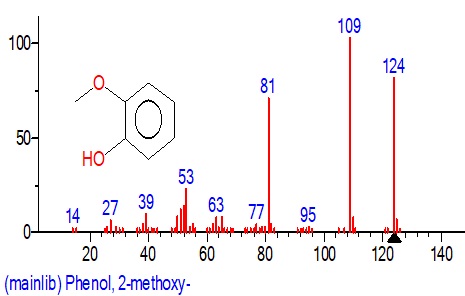Analysis of Chemical Components and Antioxidant Activity in Nutmeg Shell Liquid Smoke Processed through Rotary Evaporator Purification
Abstract
This study aims to analyze liquid smoke's chemical content and antioxidant activity from pyrolysis of nutmeg (Myristica fragrans) shell with rotary evaporator purification. A rotary evaporator purified liquid smoke from the pyrolysis of nutmeg shells. Identification of the chemical components of liquid smoke from the pyrolysis of nutmeg shells was carried out by Gas Chromatography-Mass Spectroscopy (GC-MS), and Antioxidants were measured using the DPPH (2,2-diphenyl-1-picrylhydrazyl) method with absorbance at a wavelength of λ 517 nm. The results of GC-MS analysis showed 14 peaks and 19 types of compounds detected with the 2-methylphenol compound component located at a retention time of 4.974 minutes, standing out with the largest contribution in terms of area, reaching 47.74%. The antioxidant test showed that the nutmeg shell has IC50 values before and after rotary evaporation of 0.40% and 0.07%, having strong antioxidant activity, and the results at a concentration of 3.2 mg/ml provided a level of free radical protection of more than 50%, namely 91.14%. The main compounds that play as antioxidants are phenol compounds and their derivatives, such as 2-methoxy-phenol and 2-methoxy-4-methyl-phenol.
Downloads

Copyright (c) 2024 Rommy David Watuseke, Sanusi Gugule, Johny Z Lombok

This work is licensed under a Creative Commons Attribution-NonCommercial-NoDerivatives 4.0 International License.
Authors who publish with this journal agree to the following terms:
- Copyright on any article is retained by the author(s).
- The author grants the journal, the right of first publication with the work simultaneously licensed under a Creative Commons Attribution License that allows others to share the work with an acknowledgment of the work’s authorship and initial publication in this journal.
- Authors are able to enter into separate, additional contractual arrangements for the non-exclusive distribution of the journal’s published version of the work (e.g., post it to an institutional repository or publish it in a book), with an acknowledgment of its initial publication in this journal.
- Authors are permitted and encouraged to post their work online (e.g., in institutional repositories or on their website) prior to and during the submission process, as it can lead to productive exchanges, as well as earlier and greater citation of published work.
- The article and any associated published material is distributed under the Creative Commons Attribution-NonCommercial-NoDerivatives 4.0 International License.





_copy1.png)










